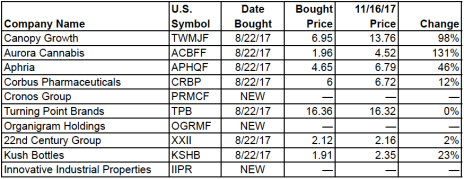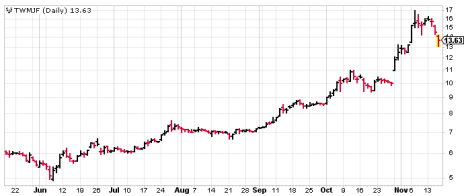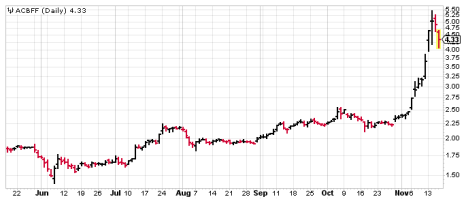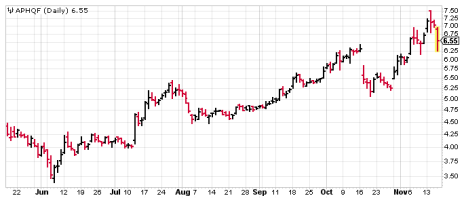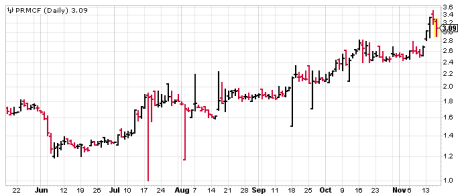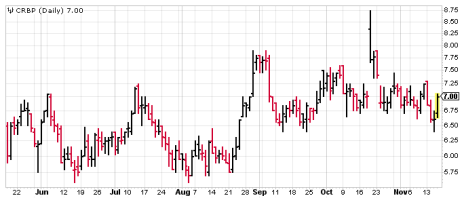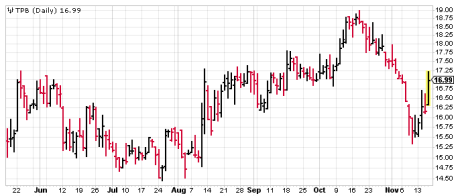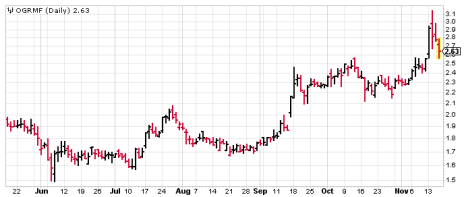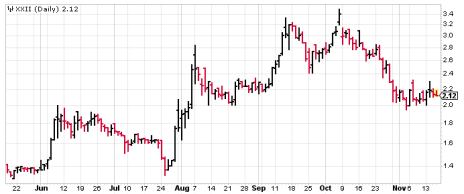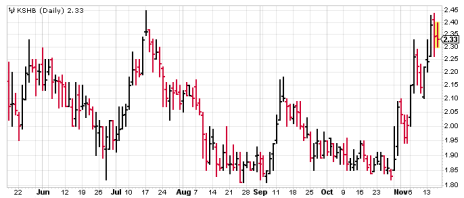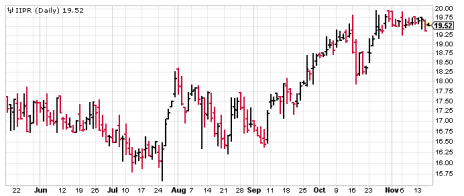If you bought a basket of my 10 Best Marijuana Stocks when the report was originally published in August, you’re off to a great start. Since that report was written, the average of the 10 stocks is up 32%, with the best stock up 131% and the worst down just 4%. Read on for more details.
Cabot Marijuana Investor—Winter 2017
If you bought a basket of my 10 Best Marijuana Stocks when the report was originally published in August, you’re off to a great start. Since that report was written, the average of the 10 stocks is up 32%, with the best stock up 131% and the worst down just 4%.
Even better, if you bought only the eight stocks that I actually recommended (I suggested waiting on two until their charts improved), your average gain was 38%—and you had no losses!
Can this pace continue? Probably not. Our timing was unusually fortunate.
On the other hand, the potential for major price appreciation by stocks in this exciting new industry was exactly the reason I wrote the first report, and exactly the reason that I’m continuing it on a quarterly basis—with occasional updates when appropriate.
The bottom line is that the marijuana industry is racing at breakneck speed toward full legalization (with Canada years ahead of the U.S.), and as a result, money is pouring into the industry, leaving no stone unturned in the hunt to build profit-making businesses.
This influx of money is great because it means the industry has plenty of capital to grow. But it does mean that there’s the potential for overvaluation, if not in the industry as a whole at least in certain small companies where dreams (of either the managers or the investors or both) are running far ahead of reality.
In short, the big potential rewards are matched by big potential risks. But that’s true of any young industry. The simplest measure of the risk is that these stocks tend to be low-priced. Of the 117 marijuana stocks I’m currently tracking (up from 104 three months ago), fewer than three dozen are priced above one dollar, and fewer than 10 are priced above 10 dollars, which is my normal cutoff point for finding stocks.
But I’m stretching the rules for these marijuana stocks precisely because I think the growth potential is huge, and I want my readers to get on board early, before these stocks get too high.
So far, as the early results show, we’re clearly on the right track.
This quarter’s 10 stocks include seven of the original 10 stocks, with three replacements. Once again, the 10 stocks are presented in order of market capitalization, from largest to smallest. And once again, I provide specific investing advice for each stock.
Lastly, at the end of this report, you’ll find brief post-mortems for the stocks that are being dropped.
1. Canopy Growth (TWMJF) (WEED in Canada)
Canada’s Biggest Grower
Canopy Growth, the biggest marijuana grower in Canada, has been one of the portfolio’s star performers over the past three months, for two good reasons.
First, investors were reassured to learn that there would be no major barriers to intra-province marijuana commerce in the country when the drug is legalized for recreational use next year—though the details are still being worked out.
Then, on October 30, alcohol behemoth Constellation Brands (STZ) (parent of Corona and Modelo beer, Robert Mondavi wine and Svedka vodka, among other brands) bought 10% of the company for roughly $190 million—a strong vote of confidence in both Canopy and the industry.
Constellation obviously has a killer distribution network, as well as great expertise in branding and marketing. But it’s not just planning to sell marijuana; it’s planning to work with Canopy to develop, market and sell cannabis-infused beverages!
Of course, those aren’t legal in Canada yet; the edibles/drinkables market is still illegal in that country. But Constellation is looking ahead. In fact, Canopy recently licensed the Trokie lozenge for sale in Canada—again, when edibles become legal. Sold widely in U.S. states where it’s legal, Trokie is a lozenge that delivers a consistent and repeatable dose of cannabis to users using the pharmaceutical industry’s most common polymer-based drug delivery system. It has no calories, and contains no gluten, nuts, artificial flavors or colors, and meets vegan standards, too.
Meanwhile, the heart of Canopy’s business remains growing and selling for the medical marijuana market. Its main brand is Tweed, the most recognized marijuana production brand in the world. Beyond that, there’s Bedrocan, the epitome of medical grade marijuana, based on strains developed in Holland over decades. And then there’s Spectrum Cannabis, a unique color-based strength and dosage system that helps users select product based on THC potency and CBD levels.
In the fiscal second quarter, ended September 30, the company sold 2,020 kilograms of cannabis, a 73% increase from the year before. Average cost per gram was $1.25 compared to $1.70 the year before.
Revenues grew 107% from the year before to $17.6 million, while the net loss was a penny per share compared to a profit of five cents the year before. But right now, the industry is not concerned about profits; it’s concerned about growing market share.
As for the stock, it was already up 40% from my August recommendation—and building a nice base at 10—when news of the Constellation investment kicked off a high-volume surge from 10 to 17. Since then, the stock been consolidating that gain, with a trading range between 13 and 16 as the 50-day moving average, now around 11, climbs closer.
If you own it, you could take some profits here if you feel over-weighted; otherwise, sit tight. And if you’re not yet on board, try to buy when the stock meets its rising 50-day moving average.
Average trading volume is 600,000 shares per day, and Canopy’s market capitalization is about $2.6 billion.
2. Aurora Cannabis (ACBFF) (ACB in Canada)
The Coors of Marijuana Brands
For the first quarter of fiscal 2018, ended September 30, Aurora saw revenues grow to $8.2 million, up 169% from the year before and up 39% from the last quarter of fiscal 2017. The average selling price per gram rose 10.3% from the previous quarter to $8.22, while the cost to produce a gram fell 9.4% from the previous quarter.
But as with Canopy, the story here is not the past but the future. Aurora is the #2 grower in Canada today, but it’s working hard to close the gap on number one.
The company’s original facility is at the foothills of the Rocky Mountains north of Calgary, and thus uses plentiful and clean Rocky Mountain water.
Under construction is a facility (Aurora Sky) at the Edmonton International Airport in Alberta, that will cover 800,000 square feet when complete. The company expects to begin planting before the end of calendar 2017, and to be harvesting in the first half of 2018. The facility is expected to produce over 100,000 kilograms annually and deliver significant economies of scale for Aurora, as well as easy access to domestic and international distribution.
Beyond that, the company has a 40,000-square-foot indoor production facility in Pointe-Claire, Quebec (Aurora Vie), which recently received its cultivation license from Health Canada and is designed to serve the rapidly growing German medical cannabis market. (With 82 million people, Germany is the largest federally-legal medical cannabis market in the world. But there is a shortage of medical cannabis in Germany. Back in May, Aurora spent $21 million to acquire a German marijuana wholesaler that distributes cannabis to 750 pharmacies.)
Additionally, in the past quarter the company acquired more two companies: BC Northern Lights, which makes systems for the safe, efficient and high-yield indoor cultivation of cannabis, and Urban Cultivator, which makes state-of-the-art indoor gardening appliances for the cultivation of organic microgreens, vegetables and herbs in home kitchens.
Also, Aurora strengthened its senior management team to ensure that it has the “leadership to further grow and build shareholder value through execution of domestic and international objectives and opportunities.” In July and August, the company appointed VPs in Finance, Market Development and Production, as well as a Chief Cultivator.
The fruits of these appointments are already being seen.
On November 2, Aurora raised $69 million in a secondary offering. Then, on Monday of this week, the company made a bid to acquire Cannimed Therapeutics (CMMDF), the biggest medical marijuana supplier in Saskatchewan, with an all-stock offering that, if completed, would give Aurora a slightly higher market value than Canopy!
The stock, which had trended generally higher since August, has been accelerating upward all month—with volume increasing as well—and it may have reached a near-term peak at 5.45 earlier this week. But it’s too early to tell. If you own, it, the same advice applies as with Canopy; take some profits or just hang on. If you don’t own it, wait for a lower-risk entry point, possibly between 2.50 and 4.
Average trading volume is 1,100,000 shares per day, and Canopy’s market capitalization is about $1.9 billion.
3. Aphria (APHQF) (APH in Canada)
The Third Largest Canada Grower
Unlike the first two Canada growers, Aphria cares about earnings. The company has now reported eight consecutive quarters of positive EBITDA.
In the first quarter of fiscal 2018, ended August 31, the company reported revenues of $6.1 million, up 40% from the year before, from selling 852 kilograms of cannabis, which cost $0.95 per gram to produce, down from $1.11 the year before.
One of Aphria’s unique characteristics is that it’s the lowest-cost producer, growing all of its cannabis in sunlit greenhouses rather than warehouses lit by electric lights. Interestingly, these facilities are located in Learnington, Ontario, which is farther south then Detroit and close to the most southerly point in Canada.
Right now, the company is constructing two additional greenhouses—one 200,000 sq. ft and one 700,000 sq. ft., with the first harvests expected in April 2018. When these are complete, the company will have 1,000,000 sq. ft. of greenhouse growing space that should produce 100,000 kilograms of cannabis annually. And as legal recreational cannabis is introduced into the market next year, Aphria assumes that its low cost will be a differentiating feature.
Today, the company is fast accumulating cash and diversifying rapidly, both by investing in other companies and enlarging its own production facilities.
The company completed its first shipment of cannabis oil to Australia, where it will be used in a human trial to test management of intractable pain in oncology patients, the first of this kind in the world. Run by MedLab, the cannabis oil will be used to make NanaBis, a powerful medicine that combines both THC and CBD in order to battle pain and cancer side effects.
Separately, Medlab has also received the go-ahead for a trial of a second cannabis-based medicine, NanaBidial, which is a CBD-only product for treating chemotherapy-induced nausea, vomiting and seizures.
Also, in recent weeks, Apria has put roughly $25 million in a new venture capital fund named Green Acre Capital that will invest in the legal cannabis industry, and made an $11.5 million strategic investment in Scientus Pharma, a biopharmaceutical company that will provide Aphria with exposure to drug development firms that target endocannabinoid receptors.
Last but not least, Aphria, like all the Canadian growers, has an eye on the developing U.S. market for cannabis—and while it’s been making some investments in U.S. companies, it’s also making shareholders aware of the legal risks of these investments. In fact, in “Management’s Discussion & Analysis” of the latest quarterly report, (available here) you can find sections titled:
• “While marijuana is legal in many US state jurisdictions, it continues to be a controlled substance under the United States federal Controlled Substances Act”
• “The approach to the enforcement of marijuana laws may be subject to change or may not proceed as previously outlined”
• “The Company’s investments in the United States are subject to applicable anti-money laundering laws and regulations”
• “The Company’s investments in the United States may be subject to heightened scrutiny”
It’s sobering stuff, and I have no doubt the lawyers made them put it in there. But I’m not worried. I’m a student of trends, and all trends for cannabis point toward increased legalization.
As for the stock, while it hasn’t been a star performer like the top two growers, it’s still done very well. The only glitch in the chart came on October 17, when the Company announced an equity financing for $80 million.
But the stock recovered soon enough, and today it’s well above its moving averages, looking a bit extended, and quite capable of correcting down to 6. If you own it, you might take some profits or just hang on tight. If you don’t own it, try to get in on a normal correction.
Average trading volume is 325,000 shares per day, and market capitalization is about $1.0 billion.
4. Cronos Group (PRMCF) (MJM in Canada)
The Investor
New addition Cronos Group is the fourth Canadian company, but it’s not so much a grower as an investor in growers.
It owns 100% of Peace Naturals, a company licensed to produce and sell medical marijuana as well as cultivate cannabis oil. Located in Simcoe County, Ontario (near Toronto), Peace Naturals has 95 acres of land.
It owns 100% of Original BC, a company that is currently licensed to cultivate and sell medical marijuana. Original BC is located on 31 acres of land in the heart of the Okanagan Valley, British Columbia—a region with a history of growing cannabis.
It owns 21.5% of Whistler Medical Marijuana Corporation, a licensed producer and seller of medical marijuana with operations in Whistler, British Columbia.
It has partnered with an Israeli kibbutz (Gan Shmuel) to grow marijuana for the export market. Israel’s climate is ideal for greenhouse cultivation, and the company expects to produce cannabis at a cost between $0.40 and $0.50 per gram. When complete, the project is expected to generate about $160 million a year by producing about 53,000 pounds of cannabis annually. Also, given that the kibbutz has nearly 5,000 acres, there is plenty of room for expansion.
And Cronos recently signed an exclusive supply agreement with Pohl-Boskamp, an international pharmaceutical manufacturer and supplier that distributes its products to over 12,000 pharmacies.
Last but not least, Cronos just raised $17.2 million in a secondary offering on November 8, so it’s likely more deals are in the offing.
As to the chart, it’s trended steadily higher since August in sympathy with the rest of the group, but it really took off over the past week (just after the secondary offering) as a rumor circulated that Aurora might attempt to acquire Cronos, in part because of the companies’ complimentary strengths in Germany.
I think this chart is buyable, and if there is no acquisition, the worst the stock can do is fall to its base at the 2.6 level.
Average trading volume is 130,000 shares per day, and market capitalization is about $490 million.
5. Corbus Pharmaceutical Holdings (CRBP)
The Synthetic Developer
Corbus is a clinical-stage pharmaceutical company that doesn’t actually use cannabis but is developing and commercializing synthetic drugs to mimic the plant’s effect on rare, chronic and serious inflammatory and fibrotic diseases. If you want to stick to pure marijuana companies, you don’t want Corbus.
On the other hand, while many Canadian growers have seen their stocks soar to the point where risk of a correction is elevated, CRBP is still in a healthy basing formation; you can buy the stock right here and get a nice piece of diversification. (However, as the months roll on, and the marijuana industry slowly matures, Corbus is likely to be squeezed out of this report.)
Corbus is currently running many clinical trials of novel therapeutics to treat rare, chronic and serious inflammatory and fibrotic diseases. The company’s lead product candidate, anabasum, is a novel synthetic oral endocannabinoid-mimetic drug designed to resolve chronic inflammation and fibrotic processes. Anabasum has generated positive data in three Phase 2 studies in diffuse cutaneous systemic sclerosis, cystic fibrosis and (on October 19) dermatomyositis, a rare autoimmune disease.
In the third quarter, the company was awarded a U.S. patent covering the use of pharmaceutical compositions comprising anabasum for treatment of rare autoimmune, inflammatory diseases through 2034.
In the fourth quarter of 2017, the company expects to commence a Phase 2 study in systemic lupus erythematosus, a Phase 3 study in systemic sclerosis and a Phase 2b study in cystic fibrosis.
Corbus has no revenues from products yet, but it did raise $32.5 million from a secondary public offering in the third quarter. And on November 8, the company reported a net loss of $0.14 per diluted share, compared to a net loss of $0.12 per diluted share the year before. The company ended the third quarter with approximately $36.6 million of cash and cash equivalents.
In my original August recommendation, I wrote, “…in recent months it’s been working to build a base at the 6 level. If you like the story, I recommend buying here. The sellers are done, and it looks like accumulation is slowing taking place.”
Since then, the stock is up a bit (it spiked briefly to a high of 8.75 on the positive results treating dermatomyositis), but the major pattern is still a base. If you like the story, you can buy here and hold patiently waiting for more positive clinical results.
Average trading volume is 690,000 shares per day, and market capitalization is about $365 million.
6. Turning Point Brands (TPB)
The Three-Legged Stool
Turning Point Brands is an old-school smokeless tobacco company that has been expanding into the marijuana and vaping markets, primarily through acquisitions of the Zig-Zag brand and several vaping brands.
Unlike many of the other companies in this report, Turning Point has very experienced management. On the other hand, debt is high, at 592% of equity. But the trends are good as the company uses its vast distribution network to evolve from an old fogey selling cancer-causing tobacco to a new-generation company selling wares that can be viewed, in some cases, as medicinal products.
In the third quarter, revenues grew 44% to a record $73.3 million, while earnings grew 12% to $0.38 per share.
Breaking the results down, smokeless products (Stoker’s snuff and nine brands of chewing tobacco, including Springfield, Beech-Nut, Trophy, Durango, Appalachia, Big Mountain and Havana Blossom) were 29% of sales in the quarter and grew 8%.
Smoking products (pipe tobacco, Zig-Zag papers, cigar wraps and cigarillos) were 37% of sales for the quarter and decreased 7%.
And NewGen products, which is where the future lies, were 35% of sales and saw growth of 664% (thanks to acquisitions). NewGen brands include VaporBeast, VaporShark, V2 and Zig-Zag Vaporizer, as well as a line of herbal smoking products.
Also, Turning Point just announced that it will begin paying a quarterly dividend, with the first dividend of $0.04 per share paid on December 15. At the current price, that will be roughly a 1% annual yield.
The stock has been in a long-term uptrend, though generally doing no better than the broad market. In my original recommendation, I noted that after hitting a high of 18 in May, the stock had pulled back to its 50-day moving average under 15, and I recommended buying there.
Since then, the stock has been up to 19, and thanks in part to that third quarter report, back down around 16. Turning Point is not going to change the world, but I think it’s a low-risk way to play the marijuana sector, particularly if you can trade the swings. Also, I’d note that its price/earnings ratio is just 10. I think you can buy here.
Average trading volume is 45,000 shares per day, and market capitalization is about $310 million.
7. Organigram Holdings (OGRMF) (OGI in Canada)
The Therapy Play
Based in the province of New Brunswick, Canada, Organigram is one of the smaller Canadian public cannabis growers—but it claims the quality of its product is the highest.
Also, thanks to its rural location, its costs are some of the lowest.
Electricity costs 5.11 cents per kWh, compared to 18 cents in Ontario, and real estate and labor are also cheaper.
Its average cost of goods sold is $2.00 per gram (which is not bad, considering that Organigram lacks the economies of scale of its larger competitors), while its average selling price per gram is $8.11.
It expects to produce 16,000 kilograms of cannabis in 2017, and 26,000 in 2018, an increase of 66%.
Third-quarter revenues were up 31% from the previous year. And the company has a cash balance of $48 million.
But Organigram is branching off in a new direction, away from what it perceives as an increasingly commoditized growing business.
In June, the company acquired Trauma Healing Centers, the only organization to boast a multi-disciplinary designation in Canada with Blue Cross for military and RCMP veteran clients. Trauma Healing Centers currently serve 4,500 patients in seven locations and the company has plans to open seven more centers.
And while these centers are staffed by physicians, psychologists, physiotherapists, counselors, dietitians and therapists, they also serve as a steady source of medical marijuana for patients.
As to the chart, it peaked at 3.35 near the end of 2016, fell below 1.75 for a period in mid-2017, and since then has been trending higher, with the action in recent weeks especially bubbly. Still, there’s decent support down at 2.4, so I recommend trying to get on board as the stock pulls back toward that level.
Average trading volume is 175,000 shares per day, and market capitalization is about $290 million.
8. 22nd Century Group (XXII)
The Low-Nicotine Story
22nd Century Group was founded on a question:
“Since coffee without caffeine and beer without alcohol are commercially available, why aren’t tobacco cigarettes without nicotine a choice for consumers?” Further, “If it were possible to produce tobacco cigarettes without nicotine, couldn’t smokers use these extraordinary cigarettes to successfully quit smoking?”
That was almost 20 years ago, and since then, the company has come a long way, using genetic technology to develop very-low nicotine tobacco and getting agencies of the U.S. government to invest more than $100 million in clinical research of the company’s proprietary SPECTRUM cigarettes.
(On the back burner are efforts to develop custom strains of cannabis as well, which is why this stock fits in this report—just barely.)
But today the story is low nicotine—and the stakes are high. On one side is the public health industry, which is fighting hard to reduce tobacco use. On the other side is the massive tobacco industry, which prefers that their customers remain addicted. And in the middle is the FDA, which in July declared that it has the authority to mandate lower nicotine levels in cigarettes sold in the United States.
The cynic in me says that the FDA is likely to bow to pressures from both the tobacco industry and politicians who benefit from the status quo. But the scientific evidence behind the company continues to grow. On October 5, the company released evidence from clinical trials that proved that “an immediate approach [to nicotine reduction] is most likely to lead to less harm,” and that there is a “greater likelihood of more rapid smoking cessation” with the immediate approach to nicotine reduction. Additionally, Henry Sicignano III, President and CEO of 22nd Century Group, said, “With the power to save millions of lives and to prevent a new generation of young people from becoming dependent on tobacco, minimally or non-addictive Very Low Nicotine cigarettes are the ultimate harm reduction strategy.”
Soon after, with the stock at a peak, on October 11, the company raised $54 million in a direct stock offering. Then in November, the company released its third-quarter results, showing revenue of $4.5 million for the period, up 46% from a year ago, and a loss of three cents per share, unchanged from last year.
In my original recommendation in August, I wrote, “22nd Century doesn’t have much in the way of marijuana-related business today—but it might in the future. And what it does have today is one of the best-looking charts in this report.”
Following that recommendation, the stock surged as high as 3.4, in two high-volume moves (culminating with the stock offering), but in the month since then, it’s once again corrected normally, and in recent weeks has been building a base at 2. This looks like a very constructive chart to me, and I recommend buying here.
Just remember that for the present, that means you’re really investing in a low-nicotine story, not a cannabis story.
Average trading volume is 3.7 million shares per day, and its market capitalization is about $265 million.
9. Kush Bottles (KSHB)
The King of Cannabis Packaging
Kush is the king of marijuana packaging, from wholesale distribution of packaging supplies to customized branding solutions for the cannabis industry. Its packaging business consists primarily of bottles, bags, tubes and containers—many of them childproof—often customized with its customers’ logos.
Thus, Kush is in a business that’s totally legal, nationally. (Of course, there are major competitors in the packaging business.)
Kush is headquartered in Santa Ana, California, but has operations in Washington and Colorado as well, and sells in every legal U.S. market—and beyond. All told, the company serves more than 4,000 business customers in North America, South America and Europe. But—typically—Kush believes the best is yet to come, with the legalization of recreational marijuana increasing demand for its certified, childproof containers.
Three months ago, I noted that KSHB was “currently working to build a base around 1.9, but it’s at risk of slipping back to 1.8.” So I didn’t recommend buying then. In fact, the stock did complete its base at 1.85 and in recent weeks has vaulted up—on big volume—to challenge its July high of 2.45. So if you bought three months ago, congratulations. Now you should think about taking some off the table.
That’s because a step back to look at the big picture reveals that the stock is still in a basing pattern, with a high of 5 in late 2016 looming over the chart.
Also, the company’s third-quarter report has not yet been released, and news about the company has been thin lately. In conclusion, I’m still intrigued by the fundamental story, but I’m waiting for a more constructive chart and entry point—as well as some constructive words from the company.
Average trading volume is 110,000 shares per day, and market capitalization is about $135 million.
10. Innovative Industrial Properties (IIPR)
The Cannabis REIT
This Maryland corporation is structured as a REIT (real estate investment trust), with a singular focus on the U.S. medical marijuana market, or more specifically, the growers and producers who are serving that market.
Founder and Executive Chairman Alan Gold previously founded two other REITs listed on the NYSE: Alexandria Real Estate Equities (ARE—the chart looks great!) and BioMed Realty, which was acquired by Blackstone in 2016 for $8 billion. So he knows what he’s doing.
At present, the firm has four properties.
The first, in New York, is leased to PharmaCann, the largest vertically integrated medical cannabis grower in the U.S.
The second, in Maryland, is still being developed (the company has invested $16.9 million in it), and has been leased to Holistic Industries, which owns and operates a total of five medical cannabis facilities in two states and the District of Columbia. These Holistic facilities include cultivation centers, processing centers and dispensaries.
The third and fourth were acquired prior to the end of the third quarter in sale-leaseback transactions with subsidiaries of Vireo Health, LLC in New York and Minnesota for an aggregate consideration of $8.4 million. The initial annual rent for each property is 15% of the purchase price, and there’s also a property management fee of 1.5% of the base rent.
Going forward, the company will continue to acquire properties through sale-leaseback transactions and third-party purchases, and tenants will generally engage in long-term triple-net lease arrangements, where the tenants are responsible for taxes, maintenance, insurance and structural repairs, in addition to base rent.
By selling properties and buildings to Innovative Industrial Properties, and then leasing them back, growers are able to redeploy the proceeds into their company’s core operations and thus grow faster than they might with capital tied up in real estate.
Additionally, the fact that Cannabis is still illegal in the U.S. nationally means that getting financing through traditional banks can be difficult for marijuana growers. So that’s an extra wind at Innovative’s back.
In a recent note, Innovative Industrial Properties said it had the capability to invest roughly $100 million more. And on October 11, the company raised $15 million through sale of preferred stock that yields 9%. So trends are good.
The company paid its first dividend in July ($0.15 per share, for an annual yield of 3.05%), and will continue to pay dividends quarterly.
And just last week the company released its third quarter earnings report. Revenues for the quarter were $1.6 million, and net income was $0.09 per diluted share while adjusted funds from operations (AFFO) were $0.44 per diluted share.
As to the stock, Innovative Industrial Properties came public in December 2016, and wandered up and down with no clear trend through the summer, but the trend has been clearly up since early September. You can see the brief selloff following the preferred stock offering in October, but the stock snapped right back, and is now trading tightly just under 20. This is a healthy pattern, and you can buy here or on any normal pullback.
Note: Before you invest in IIPR, I recommend you understand the implications of REIT taxation. One place to start is here.
Average trading volume for IIPR is 30,000 shares per day, and market capitalization is about $65 million.
Stocks Dropped:
Axim Biotechnologies (AXIM)
Axim is working on treatments for pain, spasticity and inflammation, as well as multiple sclerosis (MS) and Parkinson’s disease. In August, I wrote that the company’s only commercial product was CanChew, a CBD-based controlled-release chewing gum that contains 10 mg of CBD along with 50 mg of hemp oil.
Since then (on October 4), the United States Patent and Trademark Office issued a Notice of Allowance for a patent that claims the use of an ophthalmic solution comprising cannabinoids for the treatment of glaucoma and symptomatic relief of conjunctival inflammation.
The stock spiked higher on the news, but is now right back to the bottom of its trading range, and there’s a risk that it might fall through that bottom.
Cannabis Sativa (CBDS)
Of the 10 stocks in my original portfolio, this had the smallest market cap—but I included it because I was intrigued by its unique combination of top management, which included a Senator, a judge and a cop. But nothing much has happened at the company in recent months. My original recommendation said, “I need to see [the stock] bottom before I can recommend buying.” Hopefully, you didn’t. The stock is going nowhere.
GW Pharmaceuticals (GWPH)
This English pharmaceutical company was the highest-priced of my original recommendations, trading over $100 a share. Its goal is to be the global leader of cannabinoid-based medicines and today it’s targeting its lead drug at early-onset drug-resistant epilepsy syndromes.
But on September 29, competitor Zogenix reported impressive results from Phase 3 trials of its own drug, thus stealing some of the thunder from the expected success of GW’s own Phase 3 trials. On the news, the stock plunged to 96, but it bounced back quickly, and this week, it surged to close to its August high.
If you followed my original recommendation about buying in the lower half of the stock’s trading range, you should have a decent profit now, but today, I think there are better opportunities in lesser-known stocks.

